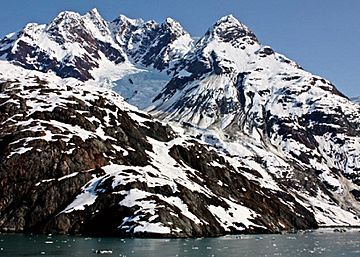Mount Cooper (Alaska) facts for kids
Quick facts for kids Mount Cooper |
|
|---|---|

Mount Cooper, northwest aspect
|
|
| Highest point | |
| Elevation | 6,780 ft (2,070 m) |
| Prominence | 1,926 ft (587 m) |
| Parent peak | Mount Abbe (8200+ ft) |
| Geography | |
| Location | Glacier Bay National Park and Preserve Hoonah-Angoon Alaska, United States |
| Parent range | Fairweather Range Saint Elias Mountains |
| Topo map | USGS Mount Fairweather D-3 |
| Climbing | |
| Easiest route | Mountaineering |
Mount Cooper is a mountain in southeast Alaska that stands 6,780 feet (2,067 meters) tall. It's part of the Fairweather Range within the larger Saint Elias Mountains. This peak is located inside Glacier Bay National Park and Preserve, right at the entrance to Johns Hopkins Inlet.
Mount Cooper is about 100 miles (161 km) northwest of Juneau. It's also about 5.6 miles (9 km) northeast of Mount Abbe, which is a taller mountain nearby. Even though Mount Cooper isn't super high, it looks very impressive because it rises sharply from the ocean in less than two miles. This dramatic rise from sea level is called relief. You can see Mount Cooper clearly from Johns Hopkins Inlet, a popular spot for cruise ships.
The mountain was named in the 1950s after William Skinner Cooper (1884-1978). He was a plant ecologist, someone who studies how plants interact with their environment. Cooper researched how plants and glaciers affected each other in the Glacier Bay area. He also led a group of scientists who suggested creating the Glacier Bay National Monument. The United States Geological Survey officially adopted the mountain's name in 1980, after Cooper passed away. The best time to climb Mount Cooper is usually from May to June, when the weather is most favorable.
Understanding Mount Cooper's Climate
Based on the Köppen climate classification system, Mount Cooper has a subarctic climate. This means it experiences very cold, snowy winters and mild summers. Temperatures can drop below −20 °C (which is −4 °F). With the wind chill, it can feel even colder, below −30 °C (−22 °F).
This cold climate helps small glaciers form and hang on the mountain's slopes. Larger glaciers, like the Kashoto Glacier to the west and the Lamplugh Glacier to the east, are also supported by this climate. Water from melting snow and ice on Mount Cooper's glaciers flows down into Johns Hopkins Inlet.
Images for kids








